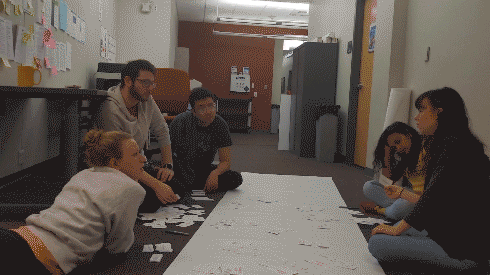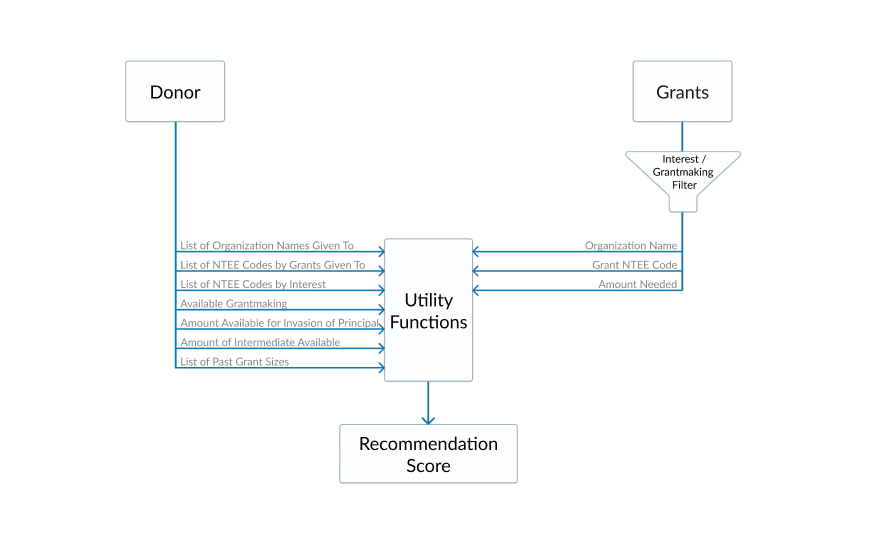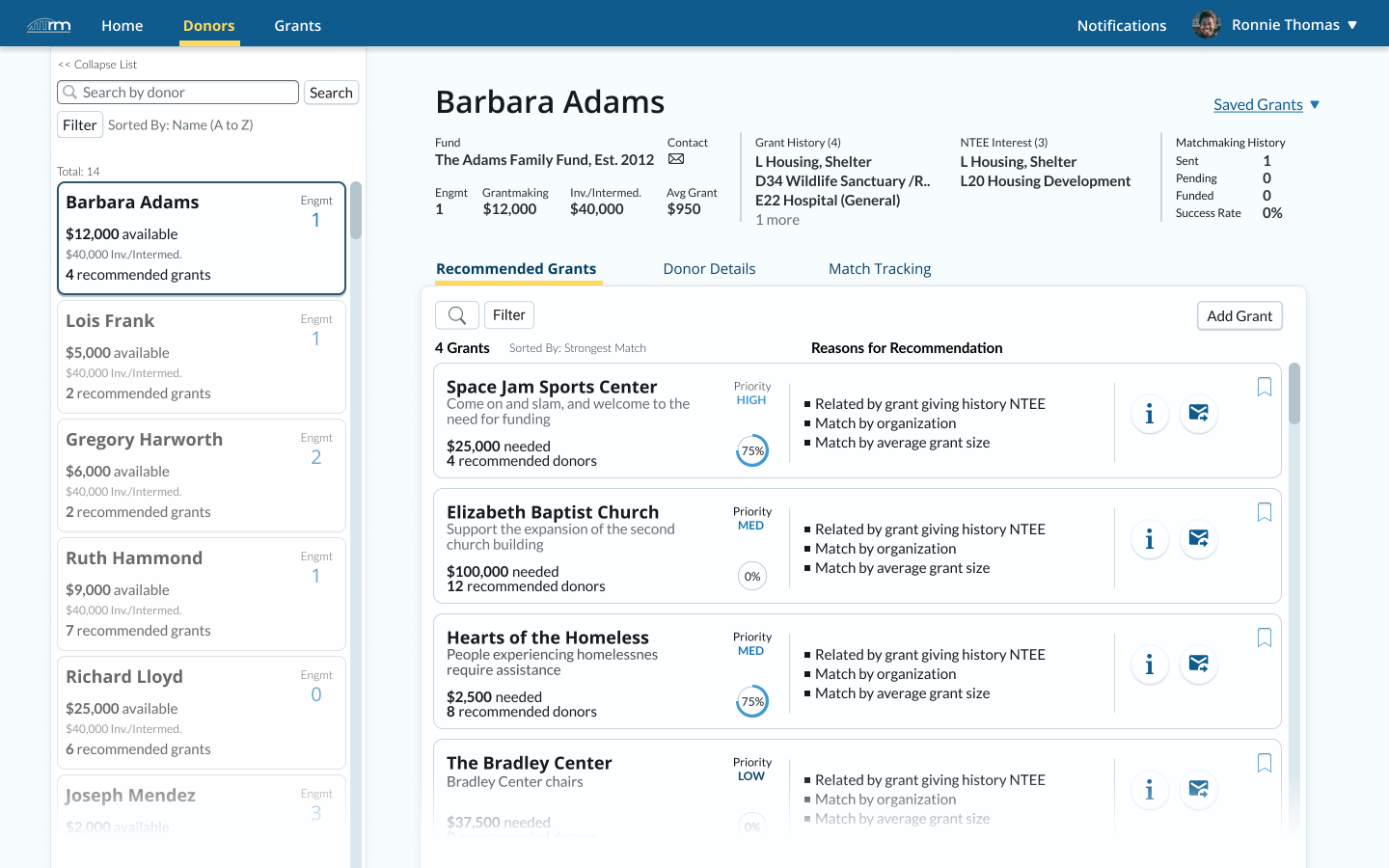Goal: Envisioning the future of responsible philanthropy for The Pittsburgh Foundation
In this research and design project, I worked with a team for The Pittsburgh Foundation
to research the philanthropic space and design a forward-thinking
technology to better connect The Pittsburgh Foundation with its donor and grantee
constituents.
My roles in the project were User Researcher and Technology Lead. As a User Researcher, I
facilitated or took notes for many interviews and tests, recruited
participants for external community foundation research, created interview guides for external
community foundations and industry experts, and reviewed and edited interview guides across the
project. As Technology Lead, I led discussions with The Foundation's IT department, wrote the
implementation guide that we handed off to our clients, and designed and wrote pseudocode for
our system's recommender algorithm.
Understanding Philanthropy: Secondary Research, Contextual Inquiry, and Observe & Intercept
At the onset of this project, I had never heard of community foundations before, let alone
how they worked. To better understand the problem space, my team and I conducted secondary
research, contextual inquiry sessions with The Pittsburgh Foundation employees, and guerrilla
interviews with Pittsburgh locals.
The first step was to gain a broad understanding of our clients and philanthropy in general by
reading countless pages of reports and brochures from The Pittsburgh Foundation in addition to
100 pages of a textbook about the psychology and economics of philanthropy. Seeking to uncover
the Pittsburgh community’s views on giving, I led interviews or recorded notes for 5 Pittsburgh
locals in downtown Pittsburgh. I personally spearheaded the team in semi-structured interviews
with subject-matter experts, designing interview guides for the two participants and leading
the interviews with them.
Through this step of the research process, my team and I were able to develop a solid
understanding of The Pittsburgh Foundation’s internal processes, their position in the community,
and the philanthropic space as a whole -- an endeavor that The Pittsburgh Foundation employees
typically complete successfully in two years -- within two months.

Narrowing on a Problem: Affinity Diagramming, Storyboard Speed-Dating, Semi-Structured Interview, and Remote Work
With much of our background research complete, my team and I moved forward with defining a
scope for our project. We synthesized our research through several affinity diagramming sessions
and distilled our findings to a handful of ideas that we tested through storyboard speed-dating
with donors. Meanwhile, we filled in any gaps in our understanding of The Pittsburgh Foundation
internal processes by interviewing employees.
Hours and hours of affinity diagramming led us to one of our first insights: collaboration leads
to responsible giving. At this point, we understood this “collaboration” as collaboration between
donors. Thus, we created 3 sets of 3 storyboards, with each set exploring methods for donor
collaboration in varying degrees.
Through these tests and revisiting our previous research, we developed new insights that pointed
us in the direction of designing an internal tool to allow The Pittsburgh Foundation to better
serve their donors and connect those donors to under-supported community needs.
During this phase of research, it grew apparent that we knew very little about The Pittsburgh
Foundation’s backend. I led the team in learning more about the technology our clients used,
creating guides and running 5 interviews with The Pittsburgh Foundation’s IT department and
personally exploring The Pittsburgh Foundation’s databases.

Testing Solutions and Validating: Concept Testing and Think-Alouds
With a narrowed focus, we tested low-fidelity sketches of concepts with employees of The
Pittsburgh Foundation and other community foundations, then iterated through our designs and
tested again and again. As we reached higher fidelity prototypes, we switched to testing our
designs through think-alouds for usability.
We identified our audience as the team at The Pittsburgh Foundation responsible for working with
donors -- a team of 4 employees. With this small but mighty team, we tested a total of 6
low-fidelity concepts and 11 mid-fidelity concepts.
Although we were able to test with our entire target userbase, my team and I wanted to collect
data from additional participants from external community foundations to inform how our designs
might scale to other populations. I took ownership of this part of the research, identifying and
reaching out to many possible participants, then creating guides and running tests or taking notes
for 4 external community foundations.

Ensuring Feasibility and Algorithm Design
One of my primary goals in this project was to ensure the feasibility of our designs for The
Pittsburgh Foundation, and to provide our clients with a detailed implementation guide. One way
that I addressed this goal was through leading discussions with members of The Pittsburgh
Foundation’s IT department, as mentioned. In addition, I also led interviews with two technical
experts. Thanks to their input, I was able to further research and recommend technology for The
Pittsburgh Foundation to use when implementing our product, and I was able to provide our clients
with an estimated time and cost for implementation.
As part of our implementation guide, I also designed and wrote pseudocode for the rule-based
recommender algorithm that serves as the backbone of our solution. My team and I decided that this
would be an essential part of the implementation guide, since the recommender algorithm, when
implemented, could serve as an MVP, sufficiently recommending donor-to-grant matches.

Results
We designed high-fidelity interactive screens for an internal web-based tool and provided this
to our clients along with a technical implementation guide, algorithm pseudocode, style guide, and
functional annotation document, research report, and final project report. In addition, we delivered a midpoint
presentation and final presentation on our work and created a project website.
Our tool, dubbed ReMatch, serves to consolidate information about donors and grants in a single
place and give The Pittsburgh Foundation employees recommended matches between donors and grants,
thus helping those employees to engage with their donors while also fulfilling community needs.
Reflection
This project was massively influential for me, not only providing me with practical experience in a variety of areas but also illuminating many of my preferences in terms of research and projects. I really appreciated the opportunity to work with a team in which everyone conducted some research and synthesis. The work felt truly meaningful and substantive, as it allowed me to reach and support those in need and populations who often go unheard in research and design. It has inspired me to do similar work in the future!
Find out more!
To read about our process in more depth, check out our Medium posts here! Or, to learn more about the final product, visit our website here!